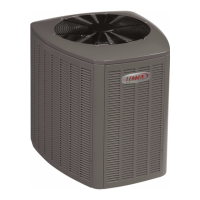
Do you have a question about the Lennox Elite XC16 and is the answer not in the manual?
| Brand | Lennox |
|---|---|
| Model | Elite XC16 |
| Category | Air Conditioner |
| Language | English |
Procedures for safely recovering HCFC-22 refrigerant from existing systems.
Warning about POE oils used with HFC-410A absorbing moisture and the need to keep the system sealed.
Cautionary advice on the hazards of brazing alloys and flux, and safety measures during brazing.
Warning about potential ignition risks when applying a brazing torch to pressurized refrigerant lines.
Importance of flushing systems with mineral oil due to incompatibility with POE oils and HFC-410A.
EPA regulations prohibiting refrigerant venting and requiring approved recovery methods.
Critical steps for flushing the line set and indoor coil with clean refrigerant.
Mandates flushing the line set and indoor coil with clean refrigerant before system operation.
Caution against flushing systems containing contaminants like compressor burnout.
Specifies that the leak detector must be capable of sensing HFC refrigerant.
Warning about the dangers of inhaling refrigerant, emphasizing responsible use and recovery.
Warning against using oxygen for purging lines due to fire and explosion risks.
Warning against deep vacuum operation and using compressors, which can cause damage and void warranty.
Emphasizes the need for a calibrated micron gauge for accurate system evacuation measurements.
Warning about electric shock hazard from unit power supplies and the necessity of grounding.
Comprehensive procedures for starting up, testing, and charging the system.
Advises pre-energizing the crankcase heater for 24 hours to prevent compressor slugging.
Steps for connecting manifold gauges and refrigerant cylinders to prepare for charge checking.
Table detailing specific refrigerant charge amounts based on line set diameter and length.
Procedure for charging the system using the subcooling method for TXV-equipped units.
Method to block outdoor coil airflow to achieve specific pressures needed for subcooling checks.
Advises using the Approach Method to verify correct refrigerant charge after adjustments.
Ensuring proper indoor coil airflow is critical before performing the approach method.
Comparing measured unit pressures with Table 2 for normal operating pressure verification.
Setting the thermostat to call for heat to establish a cooling load for testing.
Formula and steps to calculate the approach temperature (APP°) for system charging.
Crucial warning to turn off electrical power before performing any maintenance on the unit.
Detailed checks for verifying part-load and full-load capacity of two-stage compressors.
Conditions required for accurate performance checks of two-stage compressors, including airflow and charge.
Step-by-step procedure to test the operational performance of two-stage compressors.
Checklist for evaluating two-stage compressor performance during Y1 and Y2 demands.
Instructions for checking system refrigerant charge using subcooling and approach temperatures.
